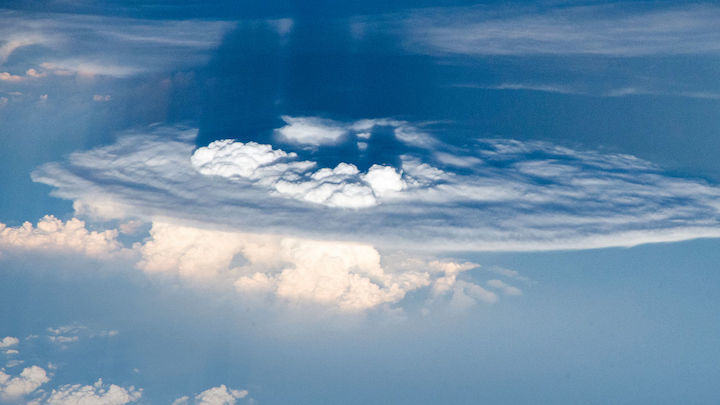29.05.2020

An “overshooting” thunderstorm can inject water into the stratosphere, where it may destroy ozone.
NASA
The end of the Devonian period, 359 million years ago, was an eventful time: Fish were inching out of the ocean, and fernlike forests were advancing on land. The world was recovering from a mass extinction 12 million years earlier, but the climate was still chaotic, swinging between hothouse conditions and freezes so deep that glaciers formed in the tropics. And then, just as the planet was warming from one of these ice ages, another extinction struck, seemingly without reason. Now, spores from fernlike plants, preserved in ancient lake sediments from eastern Greenland, suggest a culprit: The planet’s protective ozone layer was suddenly stripped away, exposing surface life to a blast of mutation-causing ultraviolet (UV) radiation.
Just as the extinction set in, the spores became misshapen and dark, indicating DNA damage, John Marshall, a palynologist at the University of Southampton, and his co-authors say in a paper published today in Science Advances. It’s evidence, he says, that “all of the ozone protection is gone.”
Scientists have long believed—at least before humanity became a force for extinction—that there were just two ways to wipe out life on Earth: an asteroid strike or massive volcanic eruptions. But 2 years ago, researchers found evidence that in Earth’s worst extinction—the end-Permian, 252 million years ago—volcanoes lofted Siberian salt deposits into the stratosphere, where they might have fed chemical reactions that obliterated the ozone layer and sterilized whole forests. Now, spores from the end-Devonian make a compelling case that, even without eruptions, a warming climate can deplete the ozone layer, says Lauren Sallan, a paleobiologist at the University of Pennsylvania. “Because the evidence is so strong, it will make people rethink other mass extinction events.”
The end-Devonian die-off has long sat in the shadow of the Late Devonian extinction 12 million years earlier, one of the planet’s largest. Likely driven by volcanoes that emitted gases that drastically cooled and warmed the planet, it killed most corals and many shelled sea creatures. But 10 years ago, work by Sallan and others revealed the end-Devonian was mighty in its own right, wiping out many plants and vertebrates, including most tetrapods, the four-limbed fish that had begun to evolve fingers and toes. Only the five-toed tetrapods survived. “It resets our own evolution,” Marshall says. “All these archaic lineages, it kicked them out of the frame.”
What the end-Devonian lacked was a cause. There was no evidence for volcanism or a giant impact, but one alluring clue was seen in the rapid formation and disappearance of rock deposits associated with glaciers, Sallan says. “Something was really screwed up with climate at that time.”
Over the past 3 decades, Marshall has explored rocks surviving from this time in eastern Greenland. At the time, this terrain lay far from the arctic, at lower latitudes, locked in the arid interior of a landmass called the Old Red Sandstone Continent. As the climate warmed after the Devonian’s last ice age, lakes formed and filled with sediment that slowly turned to mudstone, recording conditions before and during the extinction. In 2017, Marshall exhumed the perfect mudstone in a 6-meter-long drilled core.
It captures a startling transformation: Healthy fossilized spores, coated in distinctive symmetrical spikes, suddenly grow misshapen, their spikes dilapidated and uneven. Spores are a common fossil because of their armored coat, but they are vulnerable to UV radiation, much like humans; spores can even develop a “tan” in response to UV. The damage Marshall saw is consistent with such exposure, says Jeffrey Benca, an experimental paleobotanist who has linked such damage to the end-Permian extinction. “What they propose seems quite plausible,” he says.
Marshall argues that the warming climate drove more powerful summer thunderstorms, which could have injected an ozone-depleting mix of water and salts into the stratosphere. As UV rays killed off forests, nutrient runoff into the sea could have caused blooms of plankton and algae, which would have produced more ozone-destroying salts in a runaway feedback. “It looks like it might be a perfect storm,” he says.
Marshall’s scenario could explain not just the extinction, but also the many natural gas deposits dating from the period, says Sarah Carmichael, a geochemist at Appalachian State University. They formed from decaying organic matter, but no one has explained the needed surge in plankton growth. Nutrient runoff from dead forests could have fertilized the marine life.
It’s also a portent of what could happen in today’s warming world, where more powerful thunderstorms sometimes “overshoot” the troposphere and inject moisture into the dry, cold stratosphere. When combined with aerosol particles and chlorine molecules, the moisture may eat away ozone.
But atmospheric scientists can barely agree on whether these ozone depletions are happening now, let alone hundreds of millions of years ago. More overshoots occur now than expected, but whether they are spurring damaging reactions is not yet clear. Elliot Atlas, an atmospheric chemist at the University of Miami who studies this dynamic, is skeptical of Marshall’s theory. It needs much more rigorous testing in models, he says. “Is it impossible? I can’t say that.”
Carmichael, for her part, would like to see evidence beyond the pollen grains that UV drove the extinction. “I’m wary of saying UV radiation is the reason,” she says. “But I think it’s a reason.”
Quelle: AAAS
